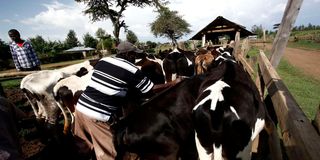All you need to know about anthrax

A veterinary officer vaccinating cows against anthrax.
What you need to know:
- It is important to vaccinate animals especially in areas prone to the disease.
An outbreak of anthrax in humans was announced in Meru County last week. Anthrax, a common disease globally that affects both livestock and human beings, is listed by the World Organisation for Animal Health.
What is anthrax?
It is caused by a bacterium called Bacillus anthracis, which forms spores.
The World Organisation for Animal Health explains that the spores are extremely resistant and can survive in the environment for decades, making the control or eradication of the disease difficult. The spores could either be in soil, or on wool or hair of infected animals.
Anthrax can cause sudden death in animals like cows, camels, goats, sheep, pigs, dogs and wild herbivores like gazelles. It can be transmitted from animals to human beings, so it qualifies as being called a zoonotic disease.
How is it spread?
When the bacterium comes in contact with oxygen, it creates the spores.
Should animals eat contaminated water or pasture which has the bacteria, they are likely to get the infection. In turn, human beings will get an infection when they eat meat from such animals. People who work in slaughterhouses are at most risk because they are likely to get an infection when they skin infected animals. Infections commonly rise after heavy rains or during dry seasons. Human beings can also get it through scratches from infected animals. It is also not advisable to eat meat from dead animals that were infected.
How would you know if your animal is infected by anthrax?
Some animals present with a bloated stomach, while others bleed from their mouths and have swelling on the face or neck. Your veterinary doctor can also assess to check whether your animal has high fever, which is also linked to anthrax. Some animals will also present with muscle tremors and shortness of breath.
What about human beings?
There are different types of anthrax - cutaneous, inhalation, intestinal and gastrointestinal forms. People get infected either through the skin, lungs or the digestive system, in that order. For those infected by skin, they are likely to experience itchiness, or have blisters and bumps. For the other types, people are likely to have fever and chills, heavy sweats, chest pain, cough, shortness of breath, confusion or dizziness, nausea, vomiting, or stomach pains, headache, general body aches, diarrhoea, stomach pain and fainting.
How do you prevent the spread of anthrax?
It is important to vaccinate animals especially in areas prone to the disease. Other specific measures include proper disposal of dead animals, carcass should not be opened since exposure to oxygen will allow the bacteria to form spores, in areas where animals have died, they should be quarantined and all carcasses disposed of preferably by burning them or conducting a deep burial with quick lime. It is also important to clean and disinfect areas where your animals live.
Additionally, here are steps included in the National Strategy for Control and Prevention of Anthrax 2021-2036.
1. Inform respective veterinary and public health authorities
2. All sick animals should be isolated and treated with effective antibiotics (if this is recommended).
3. Carcasses should not be opened and should be disposed of and all contaminated grounds and materials disinfected and decontaminated as per the guidelines.
4. Movement restriction of livestock and animal by-products from infected farms.
5. Ring vaccination of the rest of the herd and surrounding herds (radius of one to 15 km based on the production system from the index case).
6. Annual vaccination for three consecutive years after an outbreak to break the infection cycle in an area should be recommended.
7. Public education to emphasise on farmers to regularly inspect their animals, report illnesses or sudden deaths to authorities, and adhere to movement controls and dangers of handling infected animals. In addition, joint communication between the public health and veterinary teams will be helpful to allay fears in the community.
8. Conduct an epidemiological investigation to promptly identify the source of infection and to map out the extent of the outbreak.
9. Intensify surveillance and monitoring in areas surrounding the infected premises for early detection of additional cases.
10. In wildlife, controlling an outbreak primarily focuses on preventing transmission from dead animals: burning, covering, or burying carcasses to prevent access by scavengers, adopting fly control measures, restricting access to suspected contaminated areas or water sources, and when practical, safely disposing of animal carcasses and disinfection and disposal of contaminated materials. Vaccination campaigns effectively control anthrax outbreaks in livestock; however, control strategies for outbreaks in wildlife populations are limited. Vaccination in wildlife focuses primarily on endangered species.


